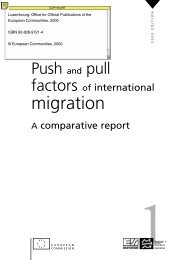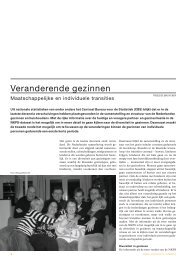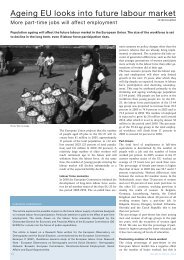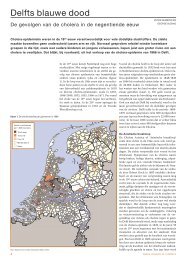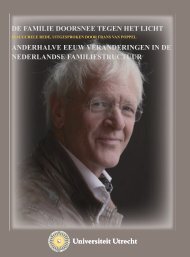Frans van Poppel: a sort of farewell. Liber Amicorum. - NIDI
Frans van Poppel: a sort of farewell. Liber Amicorum. - NIDI
Frans van Poppel: a sort of farewell. Liber Amicorum. - NIDI
- No tags were found...
Create successful ePaper yourself
Turn your PDF publications into a flip-book with our unique Google optimized e-Paper software.
Since 1995 numerous volunteers have been working to build an index <strong>of</strong> all 19 th and early20 th century civil certificates <strong>of</strong> the Netherlands, not only containing the names <strong>of</strong> all born,deceased and married persons, but also the names <strong>of</strong> their parents, places <strong>of</strong> birth, ages andpartly their occupational titles. In this so-called GENLIAS dataset, especially the marriagecertificates have been indexed, resulting in about 3,500,000 indexed certificates from almostall <strong>of</strong> the Netherlands for the period 1812-1932.To use these data for scientific research the LINKS project has been initiated by the HSN.LINKS reconstructs all 19 th and early 20 th century families in the Netherlands. Main goals<strong>of</strong> LINKS are the construction <strong>of</strong> pedigrees (linking marriages certificates <strong>of</strong> children andparents) and families (adding births and deaths to marriage certificates). LINKS is a follow-up<strong>of</strong> earlier work with the GENLIAS dataset, especially for the provinces <strong>of</strong> Zeeland, Overijsseland Gelderland which started around 2006. Actually, in 1993, <strong>Frans</strong> and I went to Zeeland todiscuss the construction <strong>of</strong> a Zeeland index <strong>of</strong> death certificates, which would have becomepart <strong>of</strong> the so-called AKON index (Algemene Klapper Overlijdensakten Nederland). TheZeeland index was realized but AKON was overtaken by GENLIAS which started in 1995and developed rapidly since then.The HSN was and is a mix <strong>of</strong> all kinds <strong>of</strong> projects directed at economic, social and demographichistory based on micro data. The total output <strong>of</strong> HSN <strong>of</strong> the last twenty years amounts to270 publications and 473 presentations. What might that have been without <strong>Frans</strong>? Perhapsnothing at all, one, given his importance for the HSN as a whole. There are 42 publications inwhich <strong>Frans</strong> was involved. Most <strong>of</strong> them focused on mortality with 24 publications, marriagecounted 9 publications, other subjects were fertility and divorce. The number <strong>of</strong> presentationswith <strong>Frans</strong> is 77 including the one in which <strong>Frans</strong> and I presented the first results <strong>of</strong> theHSN (at the Historical Demographical Conference in Montréal in 1992). We still workedwith overhead sheets and I remember that <strong>Frans</strong> came to Schiphol to present me the lastversions just before my departure to Montréal! The last ten years <strong>Frans</strong> is speeding up, givingpresentations with HSN data at an average <strong>of</strong> ten per year. And, again, almost all <strong>of</strong> thesepresentations are co-productions where <strong>Frans</strong>, as always, takes a great part <strong>of</strong> the work.The presentations <strong>of</strong> <strong>Frans</strong> are a goldmine for future work. I only have to remember thestill unpublished but quite brilliant presentation about remarriages at the SHAA Chicago2007 (Who did and who did not? Remarriage in the Netherlands during the 19 th and early20 th century). Figure 2 shows significant differences in the chance <strong>of</strong> remarrying betweenbridegrooms from different social backgrounds that are still waiting to be further analyzed,especially the question why the semi-skilled males were lagging behind in remarrying. Didthey have better health prospects? Did they have smaller families? Did they have lowerincomes? Were these workers not attractive partners for women looking for a partner? Wefound that age and marital status <strong>of</strong> the bride were very important to explain a second marriage,but why are these effects cheerfully interacting with social and provincial background? And<strong>of</strong> course the model needs to be improved as well, but that goes too far for this contribution.Anyway, with the new LINKS dataset the whole country could be covered, including effects<strong>of</strong> the first marriages as well.47






